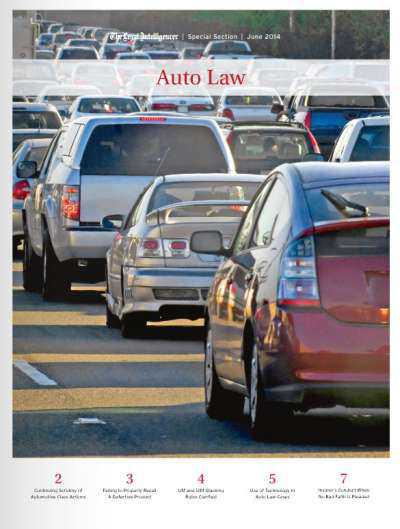Ken Fulginiti Article: “The Use of Technology in Your Auto Case.”

This article was originally published in the June 17, 2014 "Auto Law" supplement of The Legal Intelligencer, the oldest law journal in the United States, and also in the June 23, 2014 edition of the New Jersey Law Journal.
There are different forms of technology that might assist you in your auto case. Some may have been generated within the vehicle as a consequence of an accident. Some may have been created during the investigation by the reporting officers. Some may have been generated professionally by a consultant or expert. Some may simply be coincidental. Any of these may be potentially helpful in proving to the fact finder the important and essential parts of your case.
Vehicle Generated.
Most vehicles these days, cars and trucks alike, have some form of electronic device to record accident-related information. Often times, the vehicle device is triggered with a "hard brake," but the information is perishable, and may be erased with just 3 more hard brakes. With a hard brake (considered a “non-deployment event” as the airbag did not deploy), the computer will often store 60 seconds of preceding-brake activity such as acceleration, braking, cruise control, RPMs, throttle percentage, vehicle speed, and additional information. It might be critical evidence showing that an operator who claims he was driving 50 m.p.h. prior to the accident, and was accelerating and decelerating with traffic, was actually driving 75 m.p.h., and had his vehicle’s cruise control activated; thereby proving that the driver was not accelerating or decelerating with traffic, but, rather, intentionally set his cruise control at a speed in excess of the speed limit.
Deployment events, such as head-on collisions, may record seat-belt usage within the vehicle, as well as airbag codes. As you likely see when you turn on the ignition of your car, the air bag light illuminates, and then, after about five seconds, stops illuminating. What just happened? It just ran a self-diagnostic, and information about the airbag was recorded. If the light does not stop illuminating, that might be a sign of a fault, and faults will be recorded electronically. So, if you have an airbag case, and the system is downloaded, it might very well show whether there was a fault with the deployment system, as well as provide you with other crash-related data and diagnostic information such as the deployment event and speed of deployment.
While it may be difficult to “contradict” the electronic data from a vehicle, the data is not always what it seems, and may require forensic analysis to link triggering and other events to the crash events. You can be sure that the vehicle manufacturer, if they have an interest in the litigation, will have a savvy witness interpreting every microsecond contained within the data. This author has seen one witness from a large vehicle manufacturing company embrace the data when he believed it supported operator error, but downplay the data (indicating it was not reliable to determine crash dynamics, but was merely for quality control), when he believed it supported vehicle failure. Some companies, such as Mercedes Benz, Audi and Mack, either claim they do not have downloadable information or that the program to download the information is proprietary, and only they can download it.
Additionally, the information must be downloaded immediately after the accident or it could be forever lost. Some consultants can download this information, but it typically requires special equipment, cables, programs, etc. The Vetronix software presently supports many vehicle models. Usually some information, if requested timely (which might be the day of, or within days of, the accident), can be obtained. It is not uncommon, especially in truck accidents, for the trucking company to want to get its asset back on the road as soon as possible. An evidence preservation letter should be immediately issued insisting that the vehicle not be moved or touched, so that information may be downloaded.
If there is to be a challenge to the information, file a Motion in Limine. Do not wait until the witness who either downloaded the information or is relying upon it is prepared to testify. The information is too complex and might require an evidentiary hearing. See Com. v. Safka, 2012 Pa. Dist. & Cnty. Dec. LEXIS 441, 14-15 (Pa. County Ct. 2012), aff’d 1312 WDA 2012 (June 2, 2014). The information is scientific evidence and must pass muster. See Frye v. United States, 293 F. 1013 (D.C. Cir. 1923). Commonwealth v. Rodgers, 413 Pa. Super. 498, 605 A.2d 1228 (1992).
Recently, in a case of first impression, Pennsylvania has joined a number of States including Arizona, California, Florida, Georgia, Illinois, Michigan, Missouri, New Jersey, New York, Ohio, and South Carolina that have admitted properly authenticated evidence from event recorders. See Com. v. Safka, 1312 WDA 2012 (June 2, 2014). In Safka, the Superior Court, in an unpublished memorandum opinion authored by Judge Jack A. Panella, held that “black box” data is not novel, and thus passes Frye muster. The court provided a detailed history of the technology, noted that the technology was supported with proper authentication at trial, and, held that the trial judge did not abuse his discretion in admitting the evidence. While an unpublished opinion, this opinion will likely become often cited on the admissibility of this evidence in the future.
The vehicle may also have a GPS system that documents where the vehicle was at any given moment, or may identify violations of regulations. By way of example, CDL drivers are regulated by the amount of hours they can drive. Some systems will automatically flag an entry, and report back to the employer when the driver’s service time exceeds the permissible hours. Such entries might directly contradict the driver’s written logs, and may support a claim of negligent supervision. A driver and his employer will be hard pressed to argue the driver was within hours when their own computer shows otherwise. This could be a critical issue, especially if there is a concern the accident occurred due to driver fatigue.
After the accident.
After the accident the police may respond with a "total station." If you ever receive a police report with a diagram that uses precise measurements (fractions of inches), it is likely that a total station was used. If you subpoena the department for the police report, you will likely NOT get the electronic data. You will need a very specific request for that information, and sometimes it lies in a particular officer's computer. The total station provides exact measurements to points of interest in an accident, including debris fields. If you have ever seen an accident where the police spray paint circles or other markings on the road to identify debris or other material evidence, and a total station has been used, in your subsequent efforts to recreate the accident, the total station electronic data may prove invaluable to evaluate speeds, points of impact and the like. For example, the total station may identify the impact point of a motorcycle accident, and the resting place of an ejected rider. The distance the rider was ejected may then allow you to calculate the speed of the motorcycle (although if a rider has a lower torso or hip injury, such may be indicative of the rider getting caught up on the handlebars, thus affecting the calculation). If this data is available, get it and supply it to your consultant.
Do it Yourself.
Maybe there is no "black box", there is no GPS, there is no computer log, there is no total station, etc. (although if you dig enough, some of this evidence is likely to exist). You may need to hire someone to assist with your trial proofs. You might want to create an animation to demonstrate how you contend the accident occurred. Such needs to be authenticated pursuant to Pennsylvania Rule of Evidence 901, but animations are admissible, if properly authenticated, to demonstrate the accident. See Commonwealth of Pennsylvania v. Serge, 586 Pa. 671, 896 A.2d 1170 (2006) (A computer-generated animation (CGA) should be treated equivalently to any other demonstrative exhibit or graphic representation and, thus, a CGA should be admissible if it satisfies the requirements of Pa. R. Evid. 401, 402, 403, and 901). CGAs can be helpful to prove or disprove something of significance, but authentication is key. CGAs can be expensive, so you don’t want it precluded at trial because it is not properly authenticated. If a company separate from your testifying consultant is preparing the CGA, have your consultant and client work with you on the CGAs to ensure they are supported by the evidence.
Look Around.
In addition to the potential wealth of information that might exist in vehicles, or created by the police after the accident, or created by your consultant, don't forget to look for some key evidence that might demonstrate exactly how the accident happened -- videos. This author has seen videos from police cruisers, the turnpike commission, in-bus cameras and company security cameras, to name a few sources that showed either exactly how the accident occurred, or the exact vehicle positions and debris fields following the accident. Immediately after an accident, go to the site, canvas the area, look for cameras, look for banks, liquor stores and gas stations (notorious for constantly running security cameras), and make requests for preservation of videos (as sometimes they are overwritten relatively soon if nothing important to the owner occurred, i.e.: the bank, liquor store or gas station was not robbed).
So, sometimes you have to work harder to make your job easier. Turn over stones, download the vehicles, canvas the neighborhood, depose the officer, retain the consultant, etc. It might turn your case from a two version accident, to one inescapable conclusion.
Ken Fulginiti obtained an $11.4 million jury verdict in an auto accident case featured in The Legal’s just-published “Top Pennsylvania Verdicts & Settlements of 2013” report. Visit duffyfirm.com/news to read about the case.

